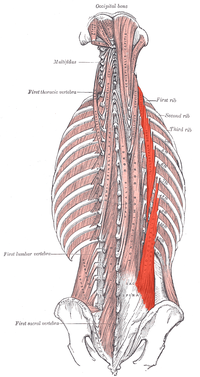Iliocostalis muscle
| Iliocostalis muscle |
|---|

|
| Back muscles of man |
| origin |
| Iliac and sacrum |
| approach |
| Ribs and cervical vertebrae |
| function |
| Stretching and sideways bending of the spine |
| Innervation |
| Spinal nerves ( rami dorsales ) |
The iliocostalis muscle ( Latin for "iliac-rib muscle") is a skeletal muscle that belongs to the autochthonous back muscles . It lies above the transverse processes (epaxial) and to the side of the longissimus muscle .
The iliocostalis muscle, like the rest of the epaxial muscles, serves as an erector and stabilizer for the spine , which is why it is also known as the erector spinae muscle ("erector of the spine"). It is located in the lateral tract of the erector spinae muscle and is part of the sacrospinal system. With unilateral contraction of this pair of muscles, the spine is bent sideways.
There is a lumbar, chest and neck section:
- The lumbar part ( Musculus iliocostalis lumborum ) arises from the intestine ( Labium externum cristae iliacae ) and sacrum ( Sacrum ) and extends to the costal processes of the upper lumbar vertebrae and the 6th – 9th. Rib.
- Chest part ( musculus iliocostalis thoracis ) arises on the lower ribs and ends on the upper ribs
- Neck part ( Musculus iliocostalis cervicis ) arises from the 6th – 3rd Rib and attaches to the transverse processes ( tuberculum posterius of the processus transversus ) the 6th – 4th Cervical vertebra, in domestic animals only on the 7th cervical vertebra.
In pigs and horses , the iliocostalis muscle is fused with the longissimus muscle.
literature
- Franz-Viktor Salomon: muscle tissue . In: Anatomy for veterinary medicine . Enke, Stuttgart 2004, ISBN 3-8304-1007-7 , pp. 147-234 .